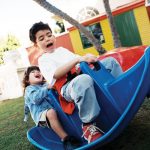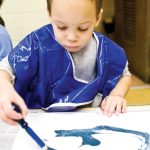Physical development is supported by the remarkable brain growth that children undergo in the first three years. Children will grow more during this time than at any other point in their lives. They often triple their birth weight by one year of age, and will have quadrupled it by age two.1 The size of their brain grows to about 80 percent of adult size by three years of age.2 One of the most important milestones children reach in their first year is learning about and experiencing gravity.3 They learn to control their movements and use their bodies in different ways. Movement, physical actions, and use of their senses are the primary ways that children explore their surroundings during these first three years. Therefore, children need to feel safe and nurtured. This is achieved through loving and attentive relationships. These positive relationships encourage healthy development, build confidence in children to try new skills, and provide them with a sense of security.
Physical development includes mastering movement, balance, and fine-motor skills. Children are born with an intense need to explore and learn about their world. The ability to move expands their ability to explore, discover, and problem-solve. Part of physical development also includes the development of perceptual abilities, which consists of taking in sensory experiences through hearing, seeing, smelling, and touching, and responding to these experiences.4 One example of this process is how children take in sensory information and respond with movement and actions. For example, an 11-month-old claps his hands after hearing music, or a 24-month-old uses his hands and fingers to squeeze clay in order to change its shape. Children’s perceptual development is important because it helps them learn and make sense of their world. Perceptual development is closely related to physical development as it helps children learn where their body is in space and allows them to respond and move accordingly.
Along with these new physical and sensory skills, children also develop their self-care skills. In infancy, children tend to their self-care needs by communicating them to attentive caregivers. As they grow, children begin to attempt some of these tasks on their own because of increasing control of their muscles, along with new cognitive abilities. The development of self-help skills depends greatly on cultural expectations and experiences. For example, in cultures where children are carried in slings or wraps for longer periods of time, walking and self-help skills tend to emerge later in the developmental trajectory.
Realistic expectations in the first three years of life are extremely important, as children all develop their physical abilities and skills at their own pace. Some children will begin to crawl as early as seven months, while others wait until nine months to begin using this particular skill. In addition, culture and experiences also play an important part in children’s physical and health development. Children will usually focus on skills that are necessary and familiar to them based on their everyday experiences.
Notes
- Shelov, S.P. & Altman, T.R. (2009). Caring For Your Baby and Young Child, Birth to Age Five. American Academy of Pediatrics. Bantam Books.
- Zero to Three (n.d.). Brain Development.
- Williamson, G. (1988). Motor Control as a Resource for Adaptive Coping. Zero to Three, 9(1), pp. 1–7. Reprinted from: Erikson Institute WebCT.
- Bjorklund, D. F. (2000). Children’s Thinking: Developmental Function and Individual Differences. Belmont, CA: Wadsworth.


 Printer-friendly PDF
Printer-friendly PDF



 Printer-friendly PDF
Printer-friendly PDF